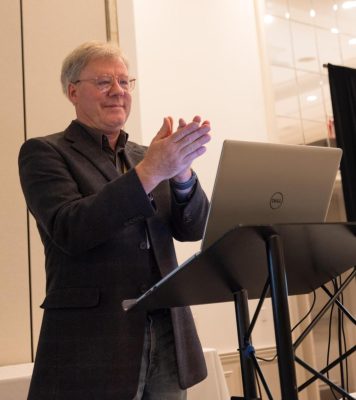Birders Flock to Sibley Lecture, Annual Conference in Tarrytown
News Based on facts, either observed and verified directly by the reporter, or reported and verified from knowledgeable sources.
By Brian Kluepfel

It took more than the pending arrival of Hurricane Ophelia to keep New York’s birding community away from the 2023 New York State Birder’s Conference in Tarrytown.
Featuring dozens of vendors, several area bird walks and lectures on topics, ranging from using e-Bird by Julie Hart and Jared Feura of the New York Breeding Bird Atlas to preventing avian collisions with glass windows by Anikó Tótha of American Bird Conservancy, the annual event was topped off by the keynote speech of David Allen Sibley, the dean of the modern birding field guide.
Saw Mill River Audubon (SMRA), spearheaded by Executive Director Anne Swaim and assisted by former SMRA board member Debbie van Zyl, organized the multiday birder’s extravaganza, which had a bit to offer for birders of all interest levels and ages.
No further proof of this was needed as Friday kicked off with the Young Birders’ Club of New York hosting a dinner and informal quiz, whose answers stumped even hardcore birders.
Saturday morning’s bird hikes were a measure of success as the rain held off until a bit later. The large group walk at Croton Point Park, for example, led by SMRA’s Larry Trachtenberg and Joe Wallace, along with Putnam Highlands Audubon Society’s Kyle Bardwell, attracted about 30 birders and notched 55 species, including several kestrels, bald eagles and many smaller birds.
After dinner, Swaim introduced the featured speaker, reminiscing, “I grew up with Peterson, National Geographic and Golden field guides. I can remember the day I opened the first Sibley guide. It was a whole new way of seeing birds.”
Sibley explained how he developed his visual acuity, beginning his remarks by recalling his early birding experiences with the New Haven Bird Club.
“All adults but me and my brother,” he laughed.
The gathering reminded him of the “community of (birding) people. I’m glad to see it alive and well in New York State.”
Sibley spoke of his head start in the field; his father was an ornithologist and legendary writer/illustrator Roger Tory Peterson a supportive Connecticut neighbor.
“Growing up I thought field guides were a natural career path,” he said.
He guided the audience through a historic slideshow journey of his artwork, beginning with a fledgling 1969 pencil drawing of a “duck hawk” (peregrine falcon) and progressing to his late ‘80s detailed work with both pencils and pen and ink. He compared the drawing process to a “one-sided interview,” where the sketcher continually asks the bird for more clues.
His attention to detail was evident even early in his career. Sibley noted that hawk-owls’ talons are never visible because they are covered by large tufts of feathers.
Sibley explained how his process evolved to where he could get more detail, but he still felt he got “the detail of the hawk, but not the spirit.” A self-effacing artist, he stated that “I get better every week, every month that goes by.” The maturation of his process and product evidenced this in drawings of the same subject ranging from 1974 to 1988.
The author and illustrator spoke of his revelatory moment – when he drew a gray flycatcher and realized while looking at it “I could recognize this bird from the drawing, and do a field guide.”
Later drawings in pen and ink, a less forgiving medium, including a lovely pyrrhuloxia (desert cardinal), further bolstered his confidence. Inspired by artists like Lars Johnson of Sweden, he forged on.
Sibley reminisced about being able to illustrate slight variances between, for example, a black-chinned and Costa’s hummingbird and realizing that positioning similar birds in precisely the same pose was important in a field guide. He explained how he builds light washes of watercolor using layers upon layers, demonstrated in the gradual development of a saw-whet owl from one of his books.
No artistic Luddite, he stated that technologies like the iPad and photoshop can produce effects like iridescence in grackles and hummingbirds that had been nearly unachievable.
It seemed Sibley’s natural curiosity and itch to improve drive him forward. When talking about new learnings from his book “What it’s Like to Be a Bird,” he noted “there are so many exciting things to be discovered. I’m glad my books have helped all of you enter into that (world).”
“It was thrilling to have birders from across New York, Connecticut, New Jersey and even Arizona celebrating Empire State birding,” added Swaim “Our team of 35 Saw Mill River Audubon volunteers did an amazing job hosting.”

Examiner Media – Keeping you informed with professionally-reported local news, features, and sports coverage.
